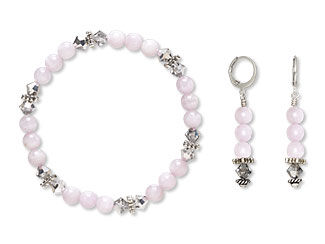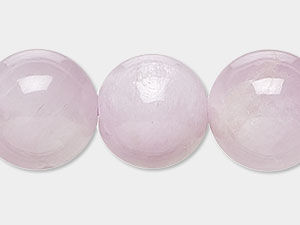Kunzite Meaning and Properties
Kunzite History
Compared to other gemstones, kunzite is a young gem. It was in 1902 that a Tiffany and Co. mineralogist by the name of George Frederick Kunz first thoroughly described kunzite. The gem was originally discovered in Connecticut, but the first large deposit was found in the San Diego area of California. Kunz determined this gemstone was an existing crystal family called spodumene, but the unique pinkish to purple color had been previously unrecognized, making kunzite unique. The next year, in 1903, a chemistry professor named kunzite in honor of Mr. Kunz.
Since kunzite's discovery, the gem has experienced growing fame, especially in high-end jewelry, due to its large size and natural clarity despite its perfect cleavage sometimes making cutting difficult. A particularly famous kunzite was a 47-karat specimen in a ring that sold for over $410,000 at a Sotheby's auction of the Estate of Jacqueline Kennedy Onassis in 1996. Kunzite and other members of the spodumene family are also used in the making of certain medicines, ceramics and batteries.
What are the Metaphysical Properties of Kunzite?
According to metaphysical beliefs, kunzite meaning is deeply connected to the heart and love. A joyful stone, kunzite is said to open and connect the heart with the mind, encouraging communion between the two. While wearing kunzite, it is thought you are better able to experience and reciprocate love. Kunzite meaning is also tied to healing heartache and calming nerves. While kunzite is not a traditional gemstone, some people have adopted the pinkish stone as a birthstone alternative for February—and kunzite does look stunning alongside amethyst. It's no surprise kunzite activates the heart chakra and helps align the crown chakra.
What is Kunzite Made From?
Kunzite is a composite of lithium, aluminum and silicate, which naturally forms in large sizes. It's fairly common to find high-quality stones that weigh at least 20 karats. The crystal structure displays distinct pleochroism, which means kunzite can appear to display two or three colors depending on the light source and orientation of the gem. Most typically, kunzite is a pale pinkish or lilac hue but can also be more vividly colored. Kunzite gem-quality stones are naturally transparent and tend to be eye clean, meaning the stone is free of inclusions to the naked eye. When kunzite gemstones do have inclusions, they are commonly aligned tubes.
Though kunzite was originally discovered in North America, the most current supply of this gemstone comes from the Middle East. Other deposits of kunzite include those found in Canada, Russia, Mexico, Sweden and Australia. Most kunzite does not receive enhancements.
- Mineral Information Lithium aluminum silicate
- Chemical Composition LiAl(Si2O6)
- Color Pink to violet
- Hardness 6-1/2 (Mohs)
- Specific Gravity 3.15 - 3.21
- Refractive Index 1.660 - 1.681
How Do You Clean Kunzite?
The color of kunzite has been known to fade with prolonged exposure to strong, direct light, so it's best not to store this stone where the sun or bright lights will constantly shine on it. Kunzite has a moderate hardness with a Mohs of 6-1/2, making it a durable stone for most jewelry applications. A sharp blow on a kunzite gemstone, though, can cause it to split due to the stone's distinct cleavage. It's best to remove kunzite jewelry before engaging in sports or other athletic activities.
To clean kunzite, use a soft brush or cloth along with soapy water. Avoid harsh cleaners, chemicals, ultrasonic cleaners and steam. It is recommended to store kunzite jewelry in a soft cloth bag or on its own velveteen pad so the stone won't scratch or be scratched by other materials.
Kunzite FAQ
Q: What gives kunzite its soft pink to violet color?
A: Kunzite gets delicate pink and violet color from trace amounts of manganese.
Q: Is kunzite a natural or treated gemstone?
A: Kunzite is usually a natural gemstone, although occasionally irradiation or heat may be used to enhance and stabilize it’s gorgeous pink and lavender color.
Q: Is kunzite sensitive to light or heat?
A: Kunzite color can fade with exposure to light and heat, so be sure to store your kunzite gemstones in a cool, dark place.
Designing with Kunzite
The soft pink and purple hues of kunzite are well-suited for feminine jewelry designs and special occasions such as Valentine's Day or Mother's Day, especially strung with pearls. Combine with other pink or purple stones for tone-on-tone effects. Amethyst, especially the lavender variety, looks stunning alongside kunzite. For pink gemstone combinations, morganite pairs perfectly. On the opposite end of the color wheel, greens provide stark contrast as well as a floral kind of vibe when kunzite is used with emerald, chrome diopside, green aventurine or varieties of jade. There really isn't a color that doesn't pair well with the soft pink to purple of kunzite. All metal tones work well with kunzite, though rose gold can especially coordinate well with its own pinkish hue.
A Design Inspiration to Get You Started
Shop for Kunzite
**Please note that all metaphysical or healing properties listed are collected from various sources. This information is offered as a service and not meant to treat medical conditions. Fire Mountain Gems and Beads® does not guarantee the validity of any of these statements.
How did you like this resource? Your feedback helps us provide resources that matter to you most.
Copyright Permissions
All works of authorship (articles, videos, tutorials and other creative works) are from the Fire Mountain Gems and Beads® Collection, and permission to copy is granted for non-commercial educational purposes only. All other reproduction requires written permission. For more information, please email copyrightpermission@firemtn.com.


